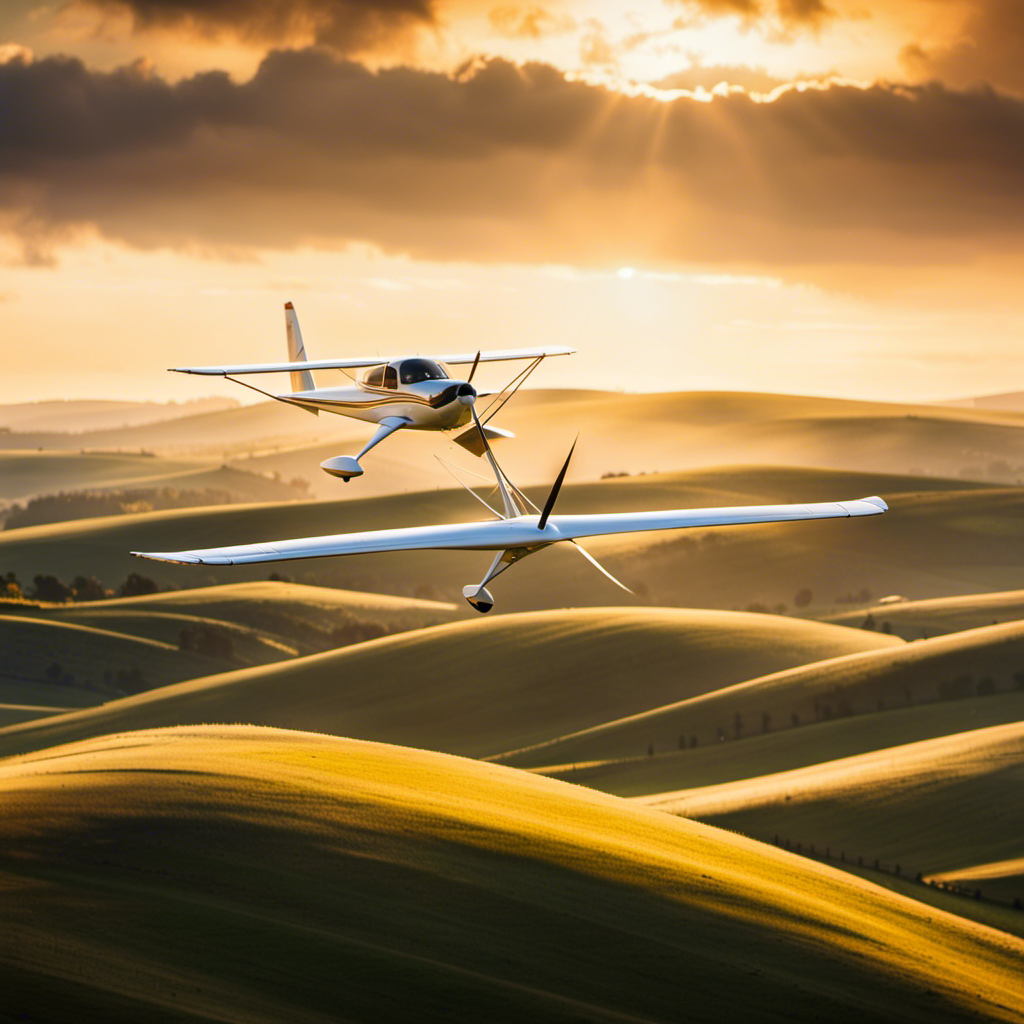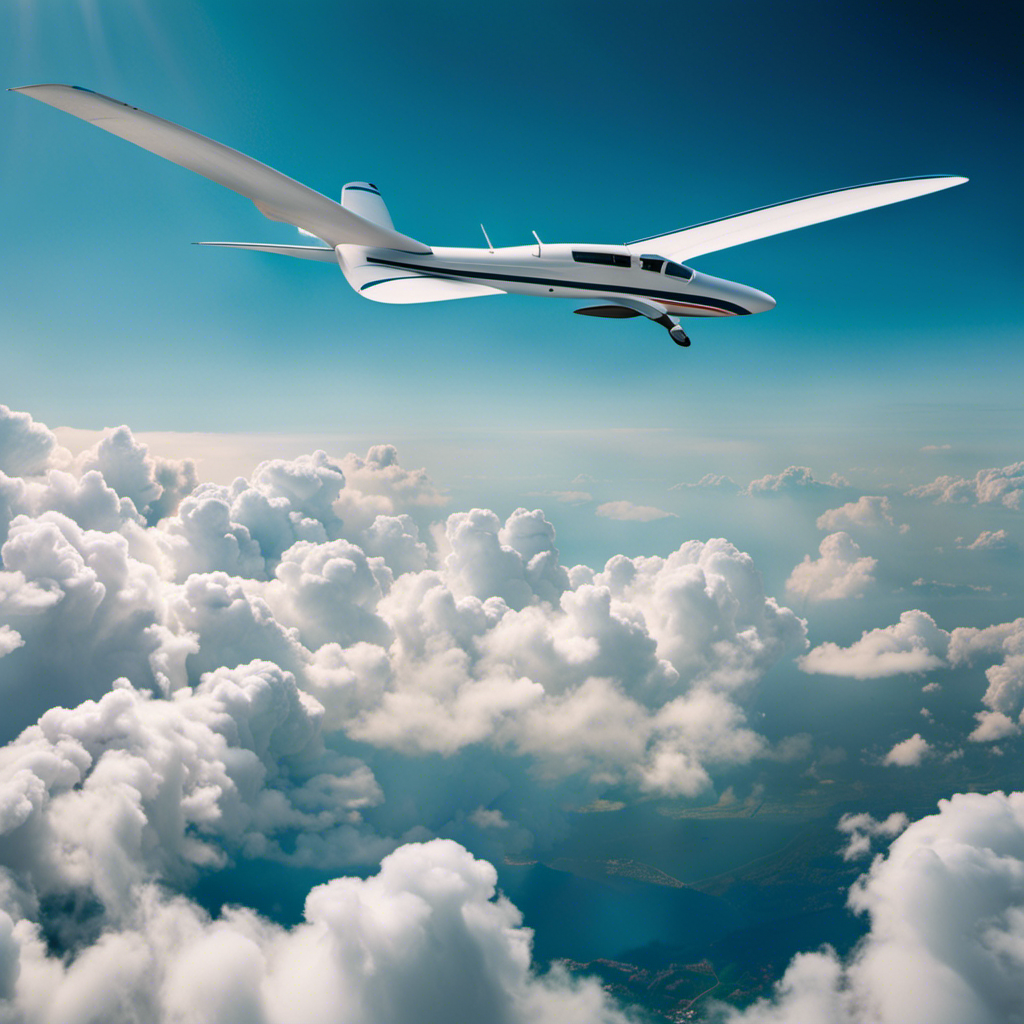Have you ever dreamt of soaring through the sky like a bird? Get ready for an exciting adventure as you delve into the world of motorized gliders.
In this comprehensive guide, we’ll take you on a journey through the history, types, and inner workings of these magnificent aircraft. Discover the advantages and challenges of flying powered sailplanes and explore popular destinations for this exhilarating sport.
Strap in, because the future of powered sailplanes is here, and you’re about to be swept away.
Key Takeaways
- Powered sailplanes combine glider efficiency with engine power to provide extended flight time and versatility in different weather conditions.
- Advancements in materials and technology contribute to improved safety in powered sailplanes.
- Pilot training programs cover theoretical knowledge, practical flight training, certification and licensing processes, and the importance of safety regulations and best practices.
- Popular destinations for powered sailplanes include mountainous regions, coastal areas, flatland areas, national parks and nature reserves, and international competitions and airshows.
The History of Powered Sailplanes
Now let’s dive into the fascinating history of powered sailplanes and how they have evolved over time.
Powered sailplanes, also known as motor gliders, have a rich history dating back to the early 20th century. The concept of combining the efficiency of a glider with the power of an engine was first explored in the 1920s. However, it wasn’t until the 1930s that significant advancements were made.
The advent of lightweight engines and improvements in aerodynamics allowed for longer and more efficient flights. Throughout the years, powered sailplanes have continued to evolve, with advancements in materials, design, and technology. These advancements have led to increased performance, better safety features, and improved handling characteristics.
Now, let’s explore the different types of powered sailplanes and their unique features.
Types of Powered Sailplanes
Take a look at the different types of sailplanes that you can find with a power source. These powered sailplanes are equipped with engines that enhance their performance and allow for extended flight durations. Here are some types you might come across:
-
Self-launching sailplanes: These sailplanes have retractable engines that enable them to take off on their own without the need for a tow or winch launch.
-
Motor gliders: These sailplanes feature engines that can be used to assist with takeoff and climb, but can also be shut off to allow for unpowered gliding.
-
Electric sailplanes: These sailplanes are powered by electric motors, which provide a quiet and efficient source of propulsion.
-
Jet-powered sailplanes: These sailplanes utilize jet engines to achieve high speeds and altitude performance.
-
Hybrid sailplanes: These sailplanes combine multiple power sources, such as electric motors and internal combustion engines, for enhanced flexibility and efficiency.
Now that you are familiar with the different types of powered sailplanes, let’s delve into how these remarkable aircraft work.
How Powered Sailplanes Work
To understand how powered sailplanes work, imagine yourself soaring through the sky with the assistance of an engine that enhances your gliding capabilities. These remarkable aircraft combine the best of both worlds – the efficiency of gliders and the power of engines. The engine, typically located at the front of the fuselage, provides the initial thrust needed for takeoff and can be used to maintain altitude or even climb. Once in the air, the engine can be shut off, and the sailplane relies on its wings to generate lift and stay aloft. This unique combination allows powered sailplanes to cover long distances and explore areas that would otherwise be inaccessible. Take a look at the table below for a visual representation of how powered sailplanes work:
| Engine Off | Engine On |
|---|---|
| Gliding | Climbing |
| Descending | Level |
| Maneuvering | Maintaining Altitude |
Now that you have a better understanding of how powered sailplanes work, let’s explore the advantages they offer.
Advantages of Powered Sailplanes
When it comes to powered sailplanes, there are several advantages to consider.
Firstly, extended flight time is a major benefit, as these aircraft are designed to stay in the air for longer periods compared to traditional gliders.
Secondly, powered sailplanes offer versatility in different weather conditions, allowing pilots to fly in a wider range of situations.
Lastly, they are also cost-effective, as they require less fuel and maintenance compared to other types of powered aircraft.
Extended Flight Time
If you want to maximize your flying time, you’ll need to consider the efficiency of your sailplane’s design. Here are three key factors to help you extend your flight time:
-
Aerodynamic Shape: Opt for a sailplane with a streamlined and low-drag design. This reduces air resistance and allows your sailplane to glide through the air effortlessly, maximizing your flying time.
-
Lightweight Construction: Choose a sailplane that is made from lightweight materials such as carbon fiber or fiberglass. The lighter the sailplane, the less energy it requires to stay aloft, increasing your flight duration.
-
Efficient Propulsion System: Look for a sailplane with a highly efficient engine and propeller combination. This ensures that you make the most of the available power, allowing you to stay in the air for longer periods.
By considering these factors, you can significantly extend your flight time and enjoy more uninterrupted soaring experiences.
Now, let’s explore the versatility of powered sailplanes in different weather conditions.
Versatility in Different Weather Conditions
In various weather conditions, powered sailplanes can adapt and perform exceptionally well. Whether you’re flying in calm winds or battling strong gusts, these versatile aircraft can handle it all. With their unique combination of a sailplane’s gliding capabilities and the added power of an engine, powered sailplanes offer a reliable and efficient means of transportation in different weather scenarios. Take a look at the table below to see just how well these aircraft can handle various weather conditions:
| Weather Condition | Performance | Adaptability |
|---|---|---|
| Calm winds | Smooth gliding | Effortless lift |
| Strong gusts | Stability | Wind resistance |
| Rainy weather | Water repellent | Increased visibility |
| Snowy conditions | Cold weather gear | Anti-icing systems |
From handling gusts to staying visible in rain, powered sailplanes are built to tackle a wide range of weather conditions. This adaptability makes them a valuable aircraft for pilots seeking a reliable and versatile mode of transportation. Additionally, their ability to navigate through different weather conditions contributes to their overall cost-effectiveness.
Cost-Effectiveness
When it comes to exploring the world of powered sailplanes, one aspect that you can’t overlook is their cost-effectiveness. Transitioning from traditional aircraft to powered sailplanes offers a variety of advantages, including greater affordability.
Here’s why powered sailplanes can be a cost-effective choice:
-
Fuel Efficiency: Powered sailplanes are designed to be highly fuel-efficient, allowing you to cover long distances without burning excessive amounts of fuel.
-
Lower Operating Costs: Compared to conventional aircraft, powered sailplanes have significantly lower operating costs. With fewer components and simpler maintenance requirements, you can save a substantial amount of money in the long run.
-
Reduced Fuel Expenses: The use of fuel is minimal in powered sailplanes, resulting in lower fuel expenses and longer flight durations.
-
Maintenance Savings: Powered sailplanes have fewer moving parts, reducing the need for frequent repairs and maintenance, which translates into additional cost savings.
With their cost-effectiveness, powered sailplanes offer an affordable way to explore the skies. However, navigating these aircraft does come with its fair share of challenges. Let’s explore the obstacles faced when flying powered sailplanes.
Challenges of Flying Powered Sailplanes
Navigating through turbulent air can be a challenge when flying powered sailplanes, but with proper training and experience, you’ll be able to handle it confidently.
Powered sailplanes, also known as motor gliders, combine the best of both worlds: the ability to soar like a glider and the flexibility of an engine. However, flying these aircraft comes with its own set of challenges.
Turbulence can pose a risk to the stability and control of the aircraft, requiring you to constantly adjust your flight path and maintain situational awareness. Additionally, the unique design of powered sailplanes, with their long wings and lightweight construction, demands a thorough understanding of aerodynamics and flight principles.
It is crucial to develop the skills and knowledge necessary to handle these challenges before taking to the skies. This can be achieved through proper training and licensing requirements, which we will explore in the next section.
Training and Licensing Requirements
When it comes to pilot training programs, there are several key points to consider.
In terms of training programs, aspiring pilots must undergo a rigorous curriculum that includes both theoretical knowledge and practical flight training.
The certification and licensing process involves meeting specific requirements set by regulatory authorities, such as the Federal Aviation Administration (FAA) in the United States, and completing written exams and flight tests.
Safety regulations and best practices play a crucial role in ensuring the well-being of pilots, passengers, and the overall aviation industry.
These regulations cover areas such as aircraft maintenance, emergency procedures, and adherence to air traffic control instructions.
Pilot Training Programs
Pilot training programs offer aspiring aviators the opportunity to learn the necessary skills and knowledge to safely operate powered sailplanes. These programs provide a structured curriculum that covers various aspects of flying, including aerodynamics, weather patterns, navigation, and emergency procedures.
Through a combination of classroom instruction and hands-on flight training, you’ll gain a solid understanding of the principles of flight and develop the necessary skills to handle different flight scenarios. Instructors, who are experienced pilots themselves, will guide you through the training process, providing feedback and guidance to help you improve.
As you progress through the program, you’ll gradually build up your flight hours and experience, preparing you for the certification and licensing process. During this process, you’ll have the opportunity to demonstrate your proficiency in operating powered sailplanes.
Certification and Licensing Process
Now that you have explored the pilot training programs, it’s time to delve into the certification and licensing process required to fly a powered sailplane.
Obtaining the necessary certifications and licenses is an essential step in becoming a qualified powered sailplane pilot. This process involves several stages, including ground school, flight training, written exams, and practical tests. It is crucial to understand the requirements and procedures involved in this process to ensure a smooth and successful certification journey.
As you embark on this path, keep in mind the following emotions that may arise:
- Excitement: The anticipation of obtaining your certification and being able to soar through the skies is exhilarating.
- Nervousness: The thought of written exams and practical tests may induce some anxiety, but remember that thorough preparation will boost your confidence.
Transitioning into the subsequent section about safety regulations and best practices, it is important to consider the guidelines that govern the safe operation of powered sailplanes.
Safety Regulations and Best Practices
Transitioning into the subsequent section, it’s crucial to understand the safety regulations and best practices that govern the operation of powered sailplanes. When it comes to flying these unique aircraft, safety should always be your top priority.
Before taking to the skies, make sure to familiarize yourself with the specific regulations set forth by the aviation authorities in your country. These regulations cover areas such as pilot qualifications, aircraft maintenance, and emergency procedures.
Additionally, it’s essential to follow best practices when operating a powered sailplane. This includes conducting thorough pre-flight inspections, maintaining proper communication with air traffic control, and practicing safe takeoff and landing techniques.
By adhering to these safety regulations and best practices, you can ensure a safe and enjoyable flight experience.
As we delve into the next section on popular powered sailplane destinations, prepare to explore some breathtaking locations where you can soar through the skies.
Popular Powered Sailplane Destinations
If you’re looking for popular powered sailplane destinations, there are some great options to consider.
One such destination is Minden, Nevada, known as the ‘Sailplane Capital of the World.’ This location boasts ideal weather conditions and stunning mountain ranges, making it a favorite among sailplane enthusiasts.
Another popular destination is Omarama in New Zealand, famous for its awe-inspiring landscapes and reliable thermals.
In Europe, Lasham in the United Kingdom is a hot spot for powered sailplane pilots, offering beautiful countryside views and a vibrant gliding community.
For those seeking a unique experience, the Alps in Austria provide breathtaking scenery and challenging flying conditions.
Transitioning into the next section on maintenance and care for powered sailplanes, it’s important to ensure your aircraft is in top condition to fully enjoy these incredible destinations.
Maintenance and Care for Powered Sailplanes
Maintaining and caring for powered sailplanes is essential to ensure their optimal performance and longevity. To keep your powered sailplane in top shape, regular inspections and maintenance are necessary. Start by cleaning the exterior of the aircraft, removing any dirt or debris that could impact its performance. Check the engine oil, coolant levels, and fuel system regularly to ensure they are functioning properly. Inspect the wings, control surfaces, and landing gear for any signs of wear or damage. It’s also important to follow the manufacturer’s recommended maintenance schedule and seek professional assistance when needed. By taking good care of your powered sailplane, you can enjoy many years of safe and efficient flying.
Once you have mastered the maintenance aspect, it’s time to consider joining the powered sailplane community. This vibrant and passionate community is filled with fellow enthusiasts who share your love for soaring through the skies. Engaging with this community can provide valuable insights, tips, and support as you continue your powered sailplane journey.
Whether it’s joining local flying clubs, attending fly-ins and airshows, or participating in online forums, there are numerous opportunities to connect with like-minded individuals. By becoming part of the powered sailplane community, you’ll not only expand your knowledge but also forge lifelong friendships with fellow aviators.
Joining the Powered Sailplane Community
Now that you’ve learned about the essential maintenance and care required for powered sailplanes, it’s time to delve into the vibrant community that surrounds this exhilarating hobby.
Joining the powered sailplane community opens up a world of opportunities for learning, networking, and sharing experiences with fellow enthusiasts. You can connect with others through local clubs, online forums, and social media groups dedicated to powered sailplanes.
These communities offer a wealth of knowledge, where seasoned pilots and newcomers alike can exchange tips, discuss the latest advancements in technology, and plan group flights.
By immersing yourself in this community, you’ll gain valuable insights, forge lasting friendships, and enhance your overall flying experience.
The Future of Powered Sailplanes
Joining the powered sailplane community offers a glimpse into the exciting possibilities that lie ahead for this remarkable sport.
The future of powered sailplanes looks promising, with advancements in technology and design constantly pushing the boundaries of what these aircraft can achieve.
One of the most significant developments is the integration of electric motors, which provide increased efficiency and reduced environmental impact. These motors, coupled with advanced battery technology, allow powered sailplanes to stay aloft for extended periods, opening up new opportunities for cross-country flights and long-distance travel.
Additionally, advancements in aerodynamics and materials have resulted in sleeker and more efficient designs, further enhancing the performance of these aircraft.
With ongoing research and development, the future of powered sailplanes holds the potential for even greater efficiency, longer flight times, and expanded capabilities, ensuring that this sport continues to captivate aviation enthusiasts worldwide.
Conclusion
In conclusion, you’ve now discovered the fascinating world of powered sailplanes. From their rich history and various types to their unique way of working, these aircraft offer a thrilling and efficient flying experience.
Despite the challenges they present, the advantages of powered sailplanes, such as their versatility and potential for soaring long distances, make them a favorite among aviation enthusiasts.
Whether you dream of exploring popular destinations or joining the vibrant community, powered sailplanes hold a promising future in the world of aviation.
So buckle up, spread your wings, and soar to new heights with powered sailplanes!
Orion, better known as “Jetstream,” is the voice that brings the stories of the skies to life. His fascination with aviation began at a young age, sparked by his father’s tales of flying and adventure. Orion’s journey into the world of gliding was serendipitous, and from the moment he took his first glider flight, he knew he had found his calling.










